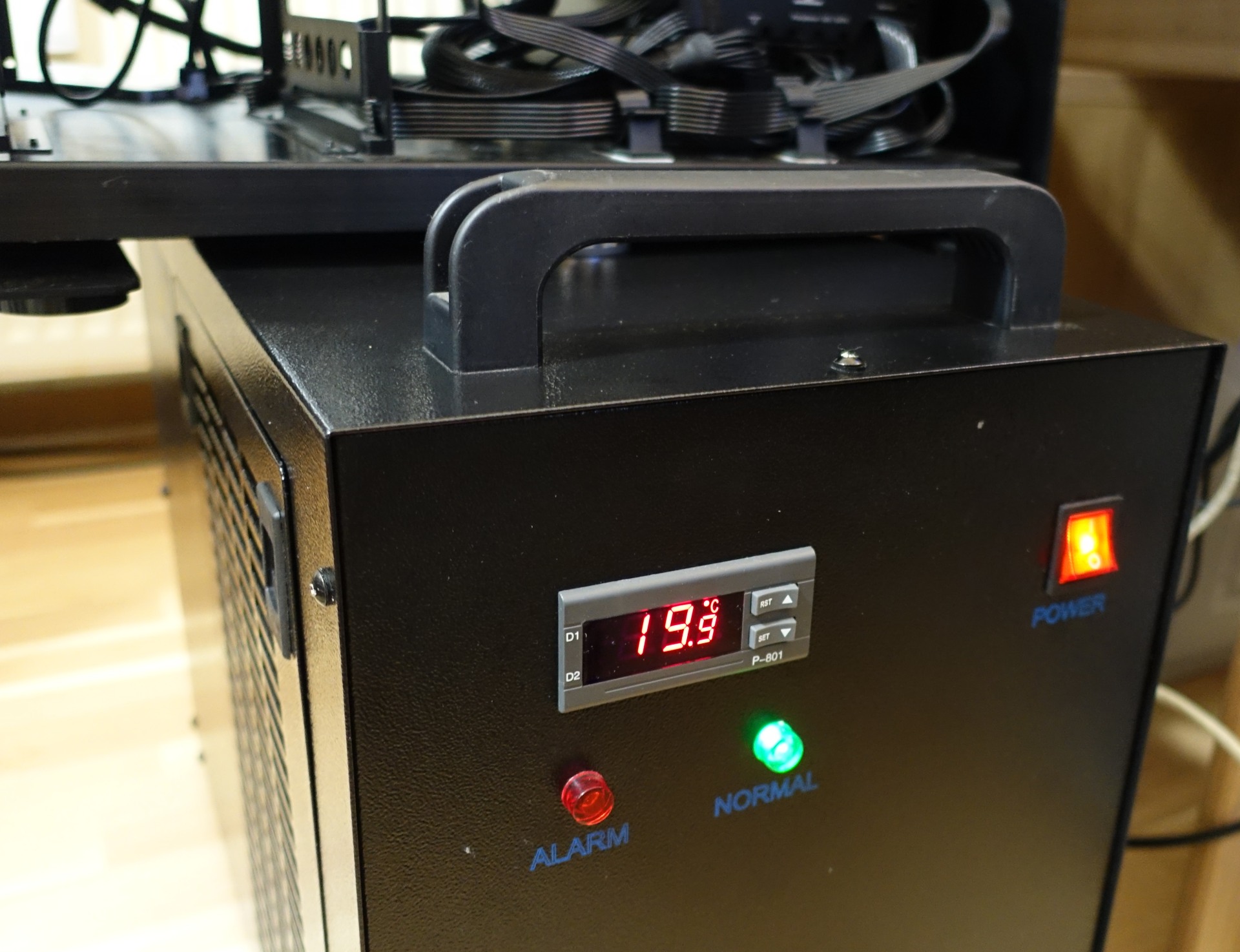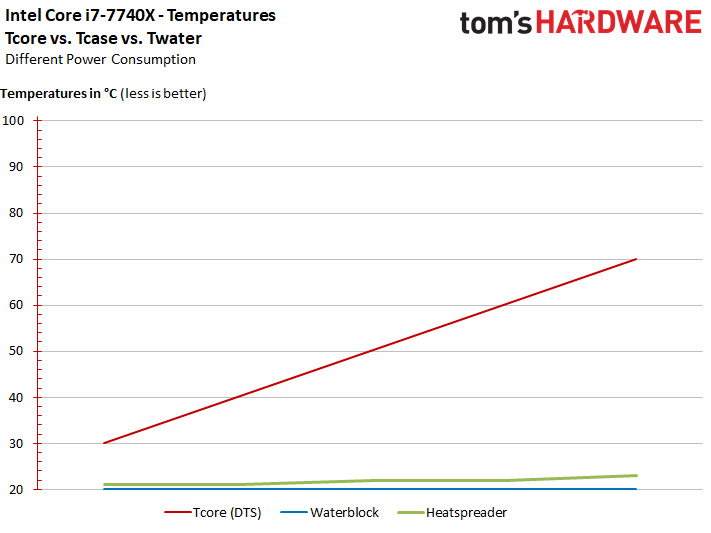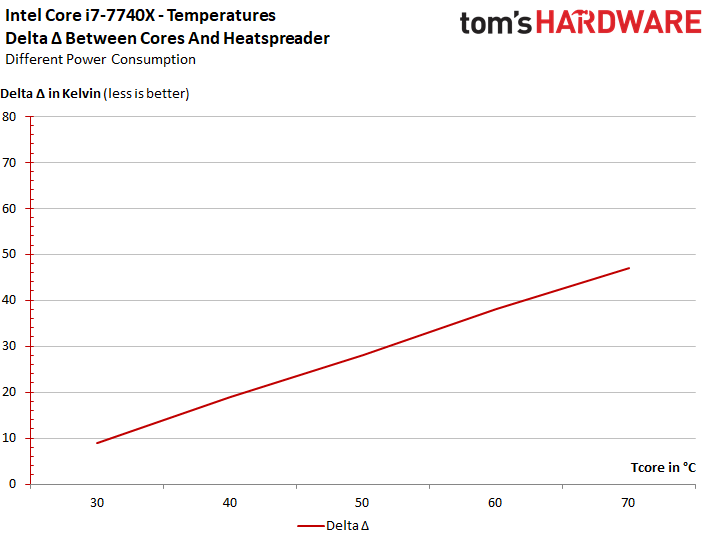Intel Core i7-7740X Kaby Lake-X Review
Why you can trust Tom's Hardware
Temperature Curves & Delta Values
Cooling Nuclear Option: The Chiller
Again, we used our Alphacool Eiszeit Chiller 2000 to produce results that are comparable to those from our Core i9-7900X review. We also used this cooler in all of our AMD Ryzen reviews, which means that those results can be compared as well.
High Temperature Differences Challenge Cooling Performance
Kaby Lake-X suffers from Intel's use of thermal paste between the die and heat spreader. Solder would have been the way to go. The difference between the water block’s temperature, which is held at a constant 20°C, and the CPU temperature (according to its sensors) demonstrate this point nicely.
The curve below shows clearly that waste heat isn't dissipated quickly enough. Just as we did in our AMD Ryzen and Intel Core i9 launch articles, we used a very thin copper plate to measure the heat spreader's temperatures as well.
The next graph represents the temperature difference between the top of the CPU's heat spreader and cores.
Our cooling solution is one of the best you can buy. Nevertheless, we measure a 48°C difference between the top of the Core i7-7740X's heat spreader and its cores. This isn't a horrible result, but it could have been a lot better.
Leakage
Next, we measured power consumption at an identical load using different cooling solutions. The leakage currents were below our measurement equipment’s accuracy range. For this reason, we didn't bother with a graph. Kaby Lake-X doesn't have a problem with leakage currents that could increase power consumption in a meaningful way.
MORE: Best CPUs
Get Tom's Hardware's best news and in-depth reviews, straight to your inbox.
MORE: Intel & AMD Processor Hierarchy
MORE: All CPUs Content
Current page: Temperature Curves & Delta Values
Prev Page Power Consumption & Overclocking Next Page Final Analysis
Paul Alcorn is the Editor-in-Chief for Tom's Hardware US. He also writes news and reviews on CPUs, storage, and enterprise hardware.
-
AgentLozen I'm glad that the option for Kaby Lake is available on the x299 chipset. In practice it seems impractical. This article shows you have to pay a lot more for slightly higher overclocking potential.Reply
I'm curious what Intel's plans are for next year regarding their high end desktop chips. They've already used the Kaby Lake X name for this generation. Should we expect Kaby Lake X 8900X? -
Kaz_2_ Intel high power consumption is not great in thr long run. You want the best for your investmentReply -
TJ Hooker ReplyThe curve below shows clearly that waste heat isn't dissipated quickly enough. Just as we did in our AMD Ryzen and Intel Core i9 launch articles, we used a very thin copper plate to measure the heat spreader's temperatures as well.
Why aren't there any numbers/divisions on the horizontal axis? Also, you say you did the same thing for the Ryzen reviews but I didn't see a similar graph in those articles (might just be blind though).
-
the nerd 389 How does the thermal performance of this chip compare to the 7700k? Specifically, does the larger surface area of the heat spreader give you a meaningful increase in thermal conductivity between the die and the heatsink?Reply -
rantoc Dang intel seem to be doing yet another stupid move with X299 beside rushing it out the door making the AMD's pretty brand new architecture/platform appear mature in comparison. As for this move - What's the incentive to pay premium for the X299 when getting a chip like this that won't even utilize it fully? The 7700k and platform are equal in performance in most tests and far cheaper...Reply
With the poor thermal transfer between the core and heat-spreader the retail chips won't likely even overclock well either. Never cared about the cherry picked "reviews" chips at all when it comes to overclocking as they very rarely represent the retail chips. -
rantoc What's the incentive to buy an expensive motherboard and yet get near zero of it's true potential with this cpu? That's paying for a lot of real estate that can't be used at all and on top of that the same poor thermal transfer between the core and heat-spreader meaning a good stable oc is harder to obtain and far less likely to happen on the retail IE non-review cherry picked ones.Reply
I think intel shoot themselves in the foot by scaling this one down to much and then couple it with an overpriced platform for what you get out of it, x299 will be good no doubt but only with the right chips and only when the rushed out of door bugs been fixed. -
This is awesome setup because you can buy x299 motherboard for $219 dollars already which gives you amazing room for later upgrade and this CPU can run 5.0Ghz easily producing very little heat. People at Toms Hardware completely missed the point. I'd rather get $219 x299 motherboard than outdated Z270 for $160.Reply


